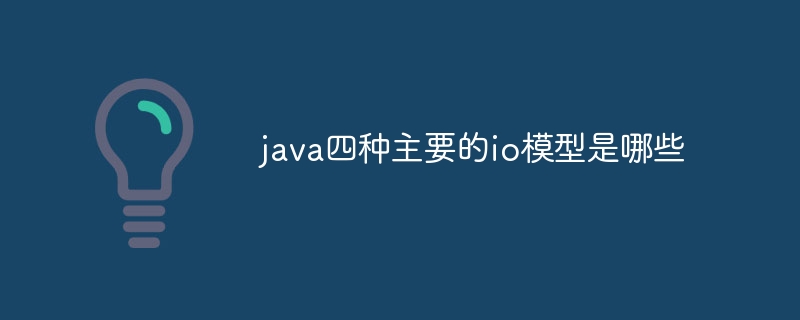
The four main io models of Java are blocking I/O model, non-blocking I/O model, multiplexed I/O model and asynchronous I/O model. Detailed introduction: 1. The blocking I/O model is one of the most basic I/O models. Its characteristic is that the current thread will be blocked when performing an I/O operation, and subsequent code will not continue to be executed until the I/O operation is completed. In the blocking I/O model, when a thread calls a read operation, if there is no data to read, the thread will block on the read operation until data arrives, when a thread calls a write operation, and so on.

In Java, there are four main I/O models, they are: blocking I/O model, non-blocking I/O model, multiple Multiplexed I/O model and asynchronous I/O model. These I/O models are used to process input and output operations, and each model has its own characteristics and applicable scenarios.
1. Blocking I/O model (Blocking I/O):
The blocking I/O model is one of the most basic I/O models. Its characteristic is that it performs I/O The current thread will be blocked during O operations, and subsequent code will not continue to be executed until the I/O operation is completed. In the blocking I/O model, when a thread calls a read operation, if there is no data to read, the thread will block on the read operation until data arrives. Likewise, when a thread calls a write operation, if the write buffer is full, the thread will block on the write operation until space becomes available. The advantage of the blocking I/O model is that it is simple and easy to use, but its disadvantage is that it is less efficient because the thread will be blocked while waiting for the I/O operation to complete and cannot handle other tasks.
2. Non-blocking I/O model (Non-blocking I/O):
The non-blocking I/O model is relative to the blocking I/O model. In the non-blocking I/O model, when a thread calls a read operation, if there is no data to read, the thread will not be blocked, but will immediately return an error code or null value. Similarly, when a thread calls a write operation, if the write buffer is full, the thread will not be blocked, but will immediately return an error code. By continuously polling the status of I/O operations, the non-blocking I/O model can process other tasks while waiting for the I/O operation to complete. The advantage of the non-blocking I/O model is that it can improve the concurrency performance of the system, but its disadvantage is that it requires frequent polling of the status of I/O operations, which will cause a waste of CPU resources.
3. Multiplexing I/O model (Multiplexing I/O):
The multiplexing I/O model uses the multiplexing mechanism provided by the operating system, such as select, poll, epoll, etc., to monitor the status of multiple I/O operations at the same time. In the multiplexed I/O model, a thread can monitor the status of multiple I/O operations at the same time. When an I/O operation is ready, the thread can perform corresponding read or write operations. In this way, the multiplexed I/O model can handle multiple I/O operations in one thread, improving the concurrency performance of the system. The advantage of the multiplexed I/O model is that it can effectively reduce the number of threads and reduce the consumption of system resources. However, its disadvantage is that the implementation complexity is high and the operating system needs to provide corresponding multiplexing mechanism support.
4. Asynchronous I/O model (Asynchronous I/O):
The asynchronous I/O model is one of the highest-level I/O models. It operates by The results are notified to the application to implement non-blocking I/O operations. In the asynchronous I/O model, after the application initiates an I/O operation, it does not need to wait for the operation to complete, but can continue to perform other tasks. When the I/O operation is completed, the operating system will notify the application program, and the application program will perform corresponding processing. The advantage of the asynchronous I/O model is that it can make full use of system resources and improve the concurrency performance of the system, but its disadvantage is that the implementation is complex and requires support from the operating system and application programs.
To summarize, the four main I/O models in Java are blocking I/O model, non-blocking I/O model, multiplexed I/O model and asynchronous I/O model. Each model has its applicable scenarios and characteristics. Developers can choose the appropriate I/O model for input and output operations based on specific needs to improve system performance and efficiency.
The above is the detailed content of What are the four main IO models in Java?. For more information, please follow other related articles on the PHP Chinese website!
